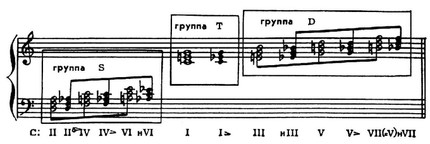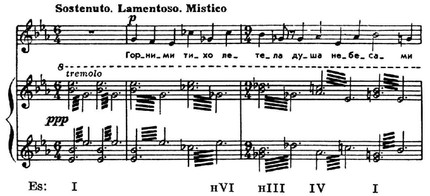
Major-minor |
Major-minor, major-minor system.
1) A term denoting the union of modes of opposite inclination within one system. The most common varieties are: the eponymous major-minor (major mode enriched with chords and melodic turns of the eponymous minor) and, somewhat less frequently, the eponymous minor-major (minor enriched with elements of the eponymous major); to M.-m. also include a mixture of parallel modes – harmonic. major and harmonic. minor. Mm. along with chromatic system is one of the types of extended modal system (“extended tonality” – according to G. L. Catuar, I. V. Sposobin).

Major-minor

Minoro major

Major; parallel system chords

Minor; parallel system chords
Application of specific harmonies M. – m. (low VI and III steps in M.-m., high III and VI in minor-major, etc.) gives the fret multicolor, brightness, decorates the melody with fresh polymodal turns:

M. P. Mussorgsky. Romance “High-mountain quietly flew …”.

S. V. Rachmaninov. Romance “Morning”.
Historically M.-m. as a special polymodal system developed in the depths of the classical. tonal system. The concept of diatonic major and minor logically precedes the concept of M.-m. However, relatives the phenomenon is found in polyphonic homophonic works. of the Renaissance (as it were, the primary, still undifferentiated M.-m.), where, for example, the rule was to complete the cadences of minor Dorian, Phrygian and Aeolian tones with a major triad (see the chord chart of such a Dorian M.-m. in the book. ” History of Musical Culture” by R. Gruber (vol. 1, part 1, M.-L., 1941, p. 399)). The remnants of this non-differentiation organically entered the tonal system in the form of the major dominant of the minor and its interaction with natural minor chords (see, for example, bars 8-11 of the 2nd movement of Bach’s Italian Concerto), as well as in the form of the major ( “Picardian”) third at the end of the minor op. In the Baroque era, the manifestation of M.-m. in the proper sense can be considered Ch. arr. the variability of the major and the minor of the same name within the framework of one construction (prelude D-dur from the 1st movement of Bach’s Well-Tempered Clavier, vols. 27-35), only occasionally reaching the introduction of chords of the minor of the same name into the major (J. S. Bach, choral prelude “O Mensch, bewein’ dein’ Sünde gross” for organ). At the Viennese classics M. – m. becomes a stronger tool due to the increase in contrast between the clearly demarcated major and minor modes. The variability of the same name is masterfully used in predicates, pre-cadence sections, in the middle and developments (D-A modulation in the 1st movement of Beethoven’s 2nd symphony), sometimes with emphatically coloristic. effect (Beethoven’s 16th sonata for piano, part 1). Wok. In music, the introduction of chords of a mode opposite in inclination also serves to reflect contrasting poetic. images (Leporello’s aria from the opera “Don Giovanni” by Mozart). The heyday of M.-m. in all its varieties falls on the era of romanticism (F. Schubert, F. Liszt, R. Wagner, E. Grieg, M. I. Glinka, M. P. Mussorgsky, N. A. Rimsky-Korsakov). Major-minor mixtures reach the greatest density and juiciness, extending to the ratio of keys, chords, and melodies. revolutions (see example above). Layering on each other, the relationship of M.-m. give rise to tertian chains typical of the era (for example, sequential follow-up: low VI to low VI leads to a return to stage I; 1st part of Rimsky-Korsakov’s Antar). In the music of the 20th century Mm. used as a normative tool along with an even more extended chromatic. system (by S. S. Prokofiev, D. D. Shostakovich, P. Hindemith and other composers).
As a special modal system M.-m. was realized in con. 19th century, especially in the teachings of the 1st half. 20th century Theorists of the 1st floor. and ser. 19th century (G. Weber, A. B. Marx, F. J. Fetis) understood the mode as a strictly limited diatonic. system, interpreting the elements of “opposition” as going beyond the limits of the system (“leiterfremde” – “alien to the scale”, according to German terminology). In Fetis’s theory of tonality, the foreboding of polysystems is already palpable, to which M.-m. (the concepts of “pluritonality”, “omnitonality”). X. Riemann speaks of “mixed moods”, proposing to call them “minor-major” and “major-minor”, but he has in mind very limited types of such mixtures (for example, the minor subdominant in major). A detailed presentation of the doctrine of M.-m. available from F. O. Gewart. In Russian lit-re idea M.-m. appears in B. L. Yavorsky (terms: initially “major-minor”, later – “chain mode”). Similar to Gewart’s theory of M.-m. put forward by G. L. Catuar (under the name “major-minor ten-ton system”) and further developed by I. V. Sposobin.
2) The designation of the classic. the tonal system of major and minor as opposed to the old, modal system and atonal systems of the 20th century.
References: Yavorsky B., The structure of musical speech (materials and notes), parts 1-3, M., 1908; Catuar G., Theoretical course of harmony, part 1, M., 1924; Practical course of harmony, parts 1-2, M., 1934-35 (Sposobin I., Dubovsky I., Evseev S., Sokolov V.); Berkov V., Harmony, part 1-3, M., 1962-1966, 1970; Sposobin I., Lectures on the course of harmony, M., 1969; Kirina K., Major Minor in the Viennese Classics and Schubert, in Sat: Art and Foreign Languages, (Issue 2), A.-A., 1966; her own, the Major-Minor system in the work of D. B. Kabalevsky (based on research materials), ibid.
Yu. N. Kholopov



